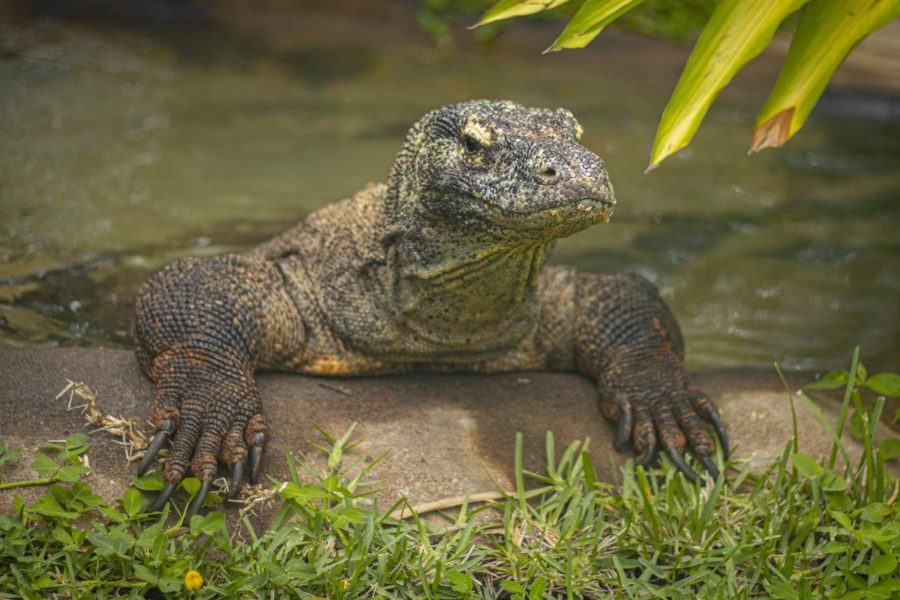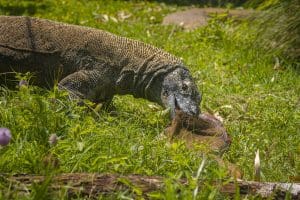

Sheldon looking regal in his habitat’s pond.
If you are a frequenter of our Lands of Change loop, you have likely peered down through some of our boardwalk’s glass panels to discover a surprising sight: Sheldon the Komodo dragon taking a snooze below your feet. Sheldon has been a long-time resident of our Zoo and a favorite among guests and keepers alike. However, unfortunately for our Zoo community, Sheldon will be leaving us around early October. While you may be disappointed to see Sheldon go, it is for an exciting reason!
Brevard Zoo participates in the Association of Zoos and Aquariums’ (AZA) Species Survival Plan (SSP) for Komodo dragons. This program provides AZA-accredited facilities with breeding recommendations for zoo residents and gives these creatures a better chance at growing and sustaining a genetically healthy population. This allows for the possibility of restoring a species’ population to its natural range. Komodo dragons are a vulnerable species with roughly less than 1,400 individuals in the wild, according to the Smithsonian National Zoo. Sheldon in particular is an ideal dragon to breed since his genetics are not yet well represented in the current population, so this exchange is an opportunity to breathe new life into the Komodo dragon populace.
“He is leaving a dragon-sized hole in our hearts for sure,” said Herps and Aquatics Area Supervisor Nicole Payne. “But we are excited about the prospect of baby Sheldons in the world!”
While Sheldon may be physically leaving us, his larger-than-dragon personality will stay with his keepers and infatuated viewers for years to come. Sheldon is a curious and active dragon who was motivated to train with his keepers. Sheldon was a “delight” to train, Nicole said. By learning to follow a target, Sheldon was able to participate in complex behaviors like moving into his secure carrier, moving onto his scale for weigh-ins, his famous exercise routine, and even participating in nail trims.
“By training husbandry and medical behaviors like this, we reduce a lot of potential stress on the animal by giving them choice and control and the ability to participate in their care,” Nicole said. “It makes everyone’s lives better!”

Sheldon enjoying eating a deer carcass.
Some of Nicole’s favorite moments with Sheldon include watching him swallow an entire deer leg whole, watching him chase after his zipline-attached food and finding him sleeping in his pond on rainy days.
Luckily for Sheldon, not much will change in his day-to-day life at the new facility. An Animal Data Transfer sheet (ADT) will be filled out for Sheldon noting his current diet, living space, medical history, enrichments, preferences, personality and trained behaviors. With this important information all in one place, his new keepers will be able to give him the best care possible.
While Sheldon will be busy hopefully helping produce little kid-modos, we will have a new Komodo dragon male moving in. Five-year-old Ryu will be with us sometime in early October. Ryu is younger and smaller than Sheldon, giving guests the opportunity to watch him grow up until he too is perhaps called for a breeding recommendation in the future. Ryu will be flown in in a secure carrier and emerge in his new habitat soon after Sheldon’s departure, so make sure to keep monitoring our Komodo dragon habitat.
Brevard Zoo is an independent, not-for-profit organization that receives no recurring government funding for our operating costs. Your generous support enables us to continue to serve our community and continue our vital animal wellness, education and conservation programs.
